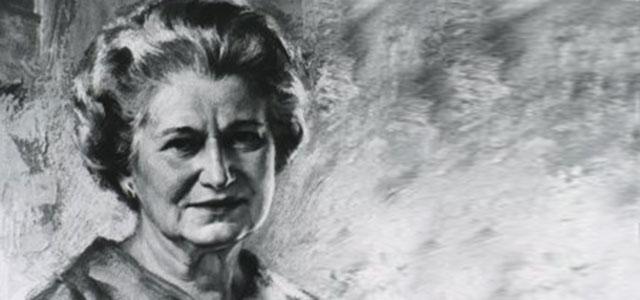
Helen Nahm, dean of UCSF School of Nursing from 1958 to 1969
Seeking Helen Nahm: Visionary Established Nursing as Its Own Unique Discipline
“Helen was very gentle and kind…a lady,” says Shirley Sears Chater of Helen Nahm, who served as dean of UC San Francisco School of Nursing from 1958 to 1969. “But when she had to work with the graduate council in the UC system to set up [what would eventually become] a PhD program in nursing, she was a steel hand in a velvet glove.”
In establishing that program, Nahm did eventually agree to call it a Doctor of Nursing Science (DNS) program – the first in the West. But partly because she never compromised on the structure and rigor of the program, in 2013, in response to an initiative of Dean David Vlahov, the University of California retroactively recognized the DNS degree as a PhD for any DNS graduate who requested the change. During her UCSF tenure, Nahm also established the Department of Social and Behavioral Sciences (the first basic science department within a school of nursing) and a number of other programs aimed at increasing the professionalism of the nursing workforce and gaining recognition for nurses as unique experts in patient care.
And as the School nearly doubled in size, Nahm mentored a generation of nursing leaders, including Chater. A former vice chancellor for academic affairs at UCSF and former commissioner of the US Social Security Administration under President Bill Clinton, Chater arrived at UCSF in 1960 specifically to work with Nahm. “She was the most influential person in my professional career,” says Chater.
Ahead of Her Time
Nahm received her nursing diploma from the University of Missouri in 1924, and within a few years, she returned to school to earn a master’s in psychology from the University of Minnesota in 1929 and, ultimately, a PhD in educational psychology and general education in 1946.
“There wasn’t a cadre of master’s and doctorally prepared nurses at the time,” says Chater drily.
Moreover, ideas that today dominate health care discussions are sprinkled throughout Nahm’s academic work. She received attention as early as 1947, when she published a piece in The Journal of Educational Research that examined what nursing students understood about the “mental hygiene” of patients. Her attention to the integration of mental and physical health is one of the many areas where Nahm was ahead of her time; anyone who thinks patient-centered or team-based care is a new idea should read through her papers. When UCSF announced her appointment as dean, Nahm said, “The primary objective of nursing education now is to develop and focus on ‘patient-centered’ nursing care.”
A series of leadership positions preceded her time at UCSF – first as principal of the School of Nursing at the University of Missouri and then as director of graduate nursing education at Duke University, before moving on to the newly formed National League for Nursing (NLN), where she pioneered efforts to accredit nursing programs.
“[She wanted to] make sure schools met rigorous standards,” says Chater.
At UCSF
When Nahm moved from the NLN to UCSF, she got to work remodeling the baccalaureate program to strengthen its focus on basic sciences, creating a master’s program that could be completed in a year, developing the DNS program and establishing social and behavioral sciences as a base for nursing research.
She accomplished all that as a female administrator in a male-dominated health sciences institution during the late 1950s and early 1960s. “Can you imagine what it was like for her, going across the country to a brand-new university where she had to convince the medical school – persuade all those men – that we needed academic programs in nursing?” says Chater.
Nahm, however, was determined. “She would sit with council members – doctors, dentists, pharmacists – and listen to all the reasons they gave about nursing not being ready for a research-oriented program at a graduate level,” Chater says. “She wouldn’t dream of saying they were wrong. She would just patiently talk about how nursing is a very specific discipline, in cooperation with medicine – and, therefore, there is nursing-specific content that has to be researched, developed and tested. She wouldn’t deviate.”
She also remained an open, diligent learner. During a 1965 sabbatical, she traveled around Europe to study nursing and nursing education there. After her retirement from UCSF, she worked with the World Health Organization and the state of California, while also traveling and speaking at various nursing-related functions.
A 1976 radio program has her declaring that nursing education was in the throes of a revolution, but not one that people should fear. She argued that the development of various nursing specialties, an emphasis on outpatient care and community health nursing, and the exploration of interprofessional education with physician colleagues all had the potential to change health care for the better.
A Mentor and a Friend
Nahm’s determined professional demeanor was only one side of her. Chater recalls a warm, attentive friend and mentor.
The two women lived in San Francisco’s Park Merced and would bump into each other at the tiny grocery store there. Over time, Nahm became a frequent source of advice and encouragement for Chater, including talking her through her PhD application process and helping her understand how to balance her professional ambitions with raising two children. “She had a wonderful, encouraging way,” says Chater.
Even after Nahm retired and Chater moved on to become vice chancellor of UCSF – the highest-ranking woman in the UC system at the time – the two women stayed in touch.
Nahm eventually returned to her home state of Missouri, though she did return to UCSF to attend the first Helen Nahm lecture in 1981. She died in 1992, at the age of 90.
While Nahm’s work sometimes goes underappreciated in the broader nursing world, Chater believes, “UCSF was so fortunate to have found her. She was one of the most extraordinary nurses in the country, and she laid the groundwork for making it the School it is today. I knew after meeting her that I wanted to pattern my career after hers.”



